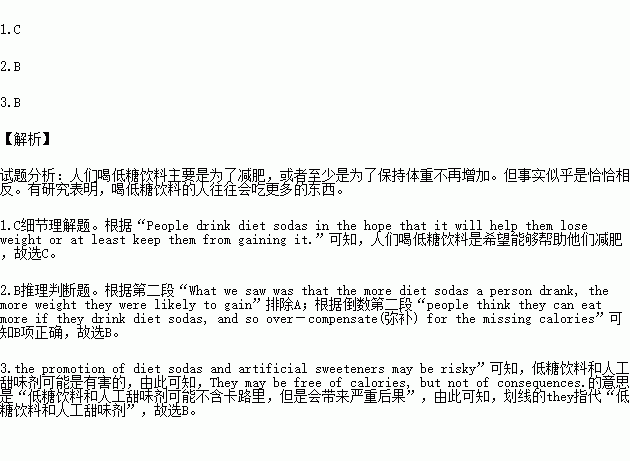题目内容
Let's face it. No one drinks diet sodas for the taste. People drink diet sodas in the hope that it will help them lose weight or at least keep them from gaining it. Yet it seems to have exactly the opposite effect, according to a new study.
Researchers from the University of Texas said those who drank two or more diet sodas a day had waist size increases that were six times greater than those who didn't drink diet sodas. “What we saw was that the more diet sodas a person drank, the more weight they were likely to gain,” said Sharon Fowler.
The study was based on data from 474 participants in a large, ongoing research project, where the participants were followed for nearly 10 years.
While the findings are surprising,they also offer some explanations.
Nutrition expert, Melanie Rogers, who works with overweight patients in New York, has found that when patients are switched from regular to diet sodas, they don't lose weight at all. “We weren't seeing weight loss necessarily, and that was confusing to us,” said Rogers.
So why would diet soda cause weight gain? No one knows for sure yet,but it could be that people think they can eat more if they drink diet sodas, and so over-compensate(弥补) for the missing calories.
A related study found some sweeteners (甜味剂) raised blood sugar levels in some mice. “Data from this and other potential studies suggest that the promotion of diet sodas and artificial sweeteners may be risky,” said Helen P. Hazuda, professor at School of Medicine of the University of Texas. “They may be free of calories, but not of consequences.”
1.People drink diet sodas to________.
A. enjoy its taste B. stay in fashion
C. achieve weight loss D. gain more energy
2.We can learn from the passage that________.
A. regular sodas make people lose more weight
B. diet soda drinkers tend to eat more food
C. diet sodas do help reduce calories
D. most blood diseases come from diet sodas
3.The underlined word “They” in the last paragraph probably refers to“________”.
A. sweeteners
B. diet sodas and artificial sweeteners
C. sodas
D. diet soda drinkers and sweetener takers
 阅读快车系列答案
阅读快车系列答案
